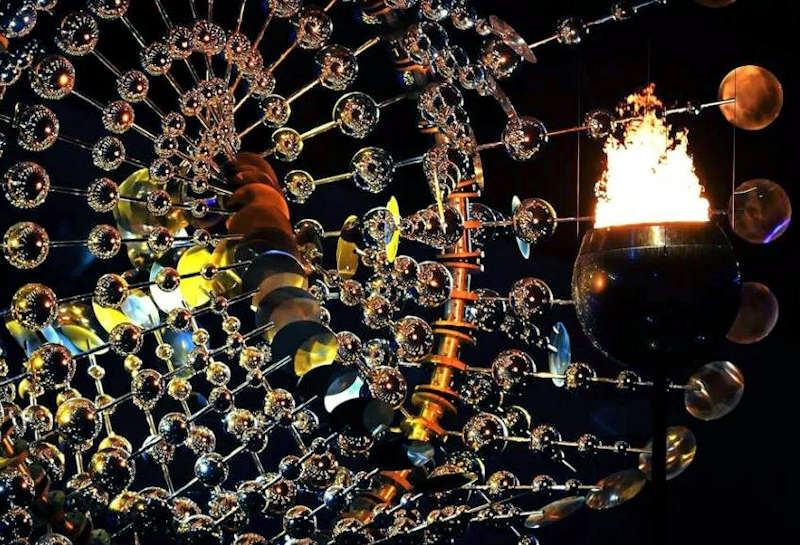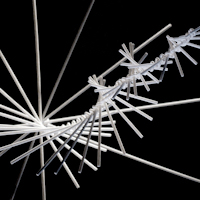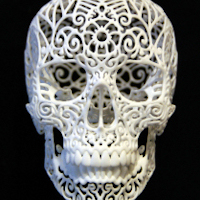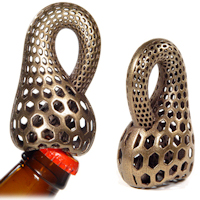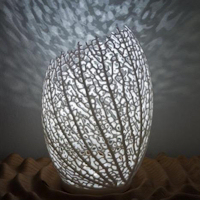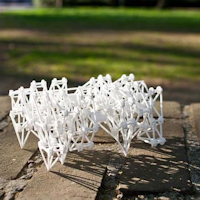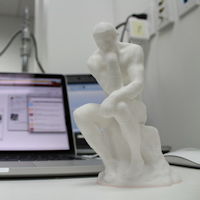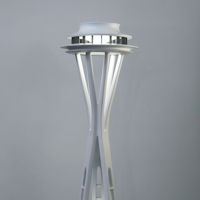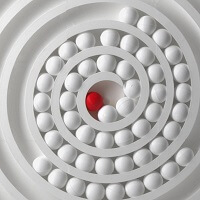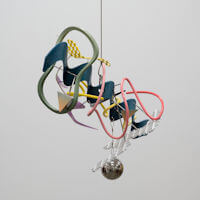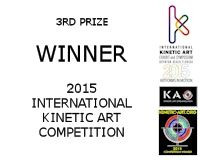What is the largest kinetic sculpture / mobile in the world?
There’s an amazing kinetic sculpture titled Kinetic Rain at Changi Airport designed by the highly creative and innovative ART + COM and manufactured and installed by MKT, Olching:
Links to various videos of the installation keep floating around social media sites calling it “the largest kinetic sculpture in the world”, spanning an area of 75 square meters (810 sq ft) and a height of 7.3 meters (24 ft). While the sculpture is an amazing accomplishment, it doesn’t seem to be the world’s largest kinetic sculpture. To my knowledge, the largest kinetic sculpture in the world (and also the largest mobile sculpture) is Alexander Calder‘s White Cascade, which hangs in the Eastburn Court of the Federal Reserve Bank of Philadelphia:
It measures approximately 100 feet (31 meters) from top to bottom, is 60 feet (18 meters) at its widest point, and weighs close to 10 tons, including the motor, surpassing Calder’s 920 pound 76-foot-long mobile (or 85 feet, depending on source) at the National Gallery of Art in Washington, DC. I’m not sure if any of his stabiles are larger, but if not, then this would also be Alexander Calder’s largest sculpture. Speaking of that large Calder mobile at the National Gallery, it is made with hollow honeycomb-type structures designed by Paul Matisse (grandson of Henri Matisse and son of Pierre Matisse) and covered with paper-thin aluminum, and aluminum and steel bars, with the stress points being strengthened with molybdenum. It weighs 930 pounds (422 kg). The previous estimates from Calder’s foundry in Biémont exceeded 5000 pounds (2268 kg). It doesn’t have a name. When Calder was asked for a title, he replied “You don’t name a baby until it is born.” But then he passed away one year before it was installed at the Gallery. The mobile sculpture has been refurbished recently.
Back to White Cascade: It took just two days to install it. The installation was carried out in two stages. In the most difficult and time-consuming part of the job, the four top-most and largest aluminum discs — still in their protective wrappings — were joined to their respective stainless steel rods, then raised one by one and linked together. The 10 lower discs and rods were linked together on the ground level, then raised into position as a unit. A crane situated on the sidewalk outside the entrance to the Bank provided the lifting power.
Finally, the wrappings were removed. The 14 white aluminum discs that comprise “White Cascade” range in size from 3.5 feet in diameter to 12.7 feet. The longest of the connecting stainless steel rods is 36 feet; the shortest, 9 feet. Powered by an electric motor, the mobile rotates clockwise on a radius of 32.5 feet.
Here’s a photo by H. Scott Heist of Calder in front of the mobile:
The mobile was installed in May 1976, Calder passed away less than six months later.
Do you know of a larger kinetic sculpture? Let me know if you do and I’ll add it to this post.
Also see my list of the 5 Largest Mobiles worldwide that I’m aware of.
– Update: –
I received an email from Anthony Howe nominating his OCTO 3 sculpture as possibly the largest outdoor permanent kinetic wind sculpture. It measures 25′ h x 30′ w x 30′ d (7.6m x 9.1m x 9.1m) and weighs 7000 pounds (3200 kg):
Since receiving the email from Anthony, it seems that he has surpassed these dimensions with the cauldron he created for the 2016 Rio Olympics measuring 40 ft (12.2 meters):
Related: Watch as Anthony Howe creates a massive, kinetic wind sculpture
– See some of my kinetic sculptures and mobiles –
Iconic 1960 Calder mobile from private collection on offer
Alexander Calder, Maripose, 1960, 30 x 67in.
Bonhams will offer Alexander Calder‘s (1898-1976) 1960 sculpture Maripose in the November 12 2013 Contemporary Art auction (est. $1,200,000-1,600,000). This stunning example of Calder’s large scale mobiles has been in private American hands for nearly 40 years in Wisconsin-based collections.
A native of Pennsylvania, Calder was born into a family of sculptors. His first solo show was held in Paris in 1927 while he was still in his twenties; he would soon become one of America’s most lauded and prolific artists. It was Marcel Duchamp who first dubbed Calder’s kinetic wire sculptures “mobiles,” – these hanging, interactive pieces would come to define the artist’s legacy.
Maripose was originally offered at Perls Gallery in New York, which represented Calder from 1954 until the artist’s death. The mobile was acquired in 1976 by a prominent private collector from Milwaukee’s Irving Galleries, and passed by descent to the present owner in 1988. The mobile was exhibited at the Milwaukee Art Museum in 1987, and is registered with the Calder Foundation.
“In Maripose, every element of Calder’s genius is evident through the striking sense of balance and momentum the sculpture evokes,” said Jeremy Goldsmith, Bonhams Director of Contemporary Art in New York. “It’s a pleasure to bring such an important work to the market after nearly four decades in private hands.”
The auction will preview at Bonhams November 9-12 2013.
3D Printing Artists
Additive manufacturing or 3D printing is a process of making a three-dimensional solid object of virtually any shape from a digital model. 3D printing is achieved using an additive process, where successive layers of material are laid down in different shapes. More and more artists and specifically sculptors are making use of this technology. This is a list of 3D printing artists that I will keep adding to:
Marco Mahler and Henry Segerman
A collection of 3D printed mobiles, the result of a collaboration between Marco Mahler, a kinetic sculptor specializing in mobiles, and Henry Segerman, a research fellow in the Department of Mathematics and Statistics at the University of Melbourne. Designed in the spring of 2013, they appear to be the first fully 3d printed mobiles in the world.
Joshua Harker is a well-known American artist and considered a pioneer & visionary in 3D printed art & sculptures. His sculpture Crania Anatomica Filigre holds the record for the most-funded kickstarter sculpture project. His work is among nearly 3000 collections that include work from notable artists such as Andy Warhol, Ron English, Shepard Fairey, R. Crumb, & Robert Williams.
Bathsheba Grossman is an artist from Santa Cruz, California who creates sculptures in bronze and stainless steel. 3D printing is her main medium but she also works with subsurface laser damage in glass. She defines herself as an artist exploring the region between art and mathematics. Her work is about life in three dimensions: working with symmetry and balance, getting from the origin to infinity, and always finding beauty in geometry.
Nervous System is a generative design studio that works at the intersection of science, art, and technology. We create using a novel process that employs computer simulation to generate designs and digital fabrication to realize products. Drawing inspiration from natural phenomena, we write computer programs based on processes and patterns found in nature and use those programs to create unique and affordable art, jewelry, and housewares.
Theo Jansen is a Dutch kinetic artist. In 1990, he began what he is known for today: building large mechanisms out of PVC that are able to move on their own, known as Strandbeest, wind-walking examples of artificial life. The 3d printed versions of the kinetic sculptures are a great example of what 3D printing is ultimately capable of, and continue to evolve with the addition of a Propeller Propulsion system.
Cosmo Wenman has a vision of digitally scanning masterpieces from museums all over the world, and making the resulting files and information freely available online. His goal is to allow anybody with a 3D printer to be able to reproduce these rare works of art in their own homes, or in the classroom. In fact, he already has several works of art that he has scanned available.
Studio Nick Ervinck applies tools and techniques from new media in order to explore the aesthetic potential of sculpture, 3D print installations, architecture and design. Through his divergent practice, a strong fascination with the construction of space is noticeable. Not only does Nick focus on the autonomous sculptural object, he also questions its spatial positioning and points to the phenomenological experience and embodiment of space.
Linlin (from China) and Pierre-Yves (of French origin) are young artists who were able to blend their cultural differences and artistic skills to make create a partnership of unexpected creativity. These artists met many years ago during their art studies – she brought a master’s degree in digital design and he, a diploma in 3D video production. The chemistry between these two artists was immediate, creating works that are a tribute to nature, knowledge and human feelings.
Monika Horčicová is one of the hottest emerging artists in the Czech Republic. Born in Prague, she currently resides in Brno where she studies at the Faculty of Fine Arts at Brno University of Technology under the tutelage of Prof. Michal Gabriel. Her work explore themes of infinity; a repeated cycle of conception and death. Rather than looking at bones as a symbol of morbidity, she aims to show them as objects that can be beautiful when we view them properly.
Michaella Janse van Vuuren is a designer and artist with a PhD in Electrical Engineering. These diverse interests enable her to create sculptures that are technically complex and artistically competent, with a strong focus on design for 3D printing or additive manufacturing. She writes: “I love the challenge of creating something that is imagined and then designed on computer and seeing if my idea printed out as envisioned. The first time I hold the design in my hand is when the finished product comes out of the 3D printer.”
Louis Pratt’s approach to sculpture is novel and ground breaking. He starts by 3D scanning forms (people) from the real world into the digital world. With these digitized forms he then uses digital sculpture tools to manipulate the scanned data. He explores many types of algorithms and applies them to sculpture.The data is then rapid prototyped back from cyber space into the real world.
Isaïe Bloch, founder of Ergatory, focuses his ongoing research and design ambitions on the correlation between craftsmanship and additive manufacturing within several creative domains including architecture, fashion and plastic arts. He has won the ‘Artist of the Year Award’ at the 2013 3D Printshow in London.
Gilles Azzaro, a French digital artist exposed his latest work at the 3D Printshow in London this year. The voice sculpture print: Barack Obama – Next Industrial Revolution. The 3D printed sculpture is the three-dimensional materialization of President Obama’s voice-print. The 3D voice-print portrays an extract of President Obama’s February 2013 State of the Union Address.
UK designer Lionel Theodore Dean believes in complexity. His objects are defiantly non-square, often pushing the boundaries of the functional object categories all industrial design adheres. Working with rapid prototyping techniques like laser sintering as a designer-in-residence at the University of Huddersfield, Dean realized that these methods were fully capable of producing high-quality objects fit for the consumer market.
Lumenique, the art and design studio of Kevin Lee Willmorth, designs and creates sculptural portable lighting, with designs inspired by architecture and machinery, which includes lighted objects using 3D printing exclusively. In 2010, Kevin created 53 unique functioning SSL products in 52 weeks as an exercise in the creative use of technology. You can also find out more about his process on his blog.
Ivo Meier creates digital art that goes beyond traditional art. He uses digital technologies, namely 3D printing since 2017 to make interactive sculptures that exist in both real and virtual worlds. He combines art and technology in a unique and creative way that engages and inspires the viewer. His art is not only aesthetic, but also meaningful and value-driven. He explores themes of human existence, freedom, purpose, and transformation. He is an artist who pushes the limits of the digital art field and reveals new opportunities.
Trained as an architect and followed by a career in design and fabrication, Sam Wood Wilson uses technology and architectural tools to create assemblages that reconfigure aesthetics and formal tropes from global art and design trends into new worlds and ideas. By sculpting his reaction to the relationship of designed content, contemporary aesthetic, and technology, he creates a narrative that conveys a world between the physical and digital, creating an opportunity for reflection on our ever changing societal structures.
I’ll be adding to this list over time …
If you’re a 3D print artist and would like to be added to this list, please contact me.
Designs for a custom mobile for a private residence in Cape Cod
Designs / sketches for a custom hanging mobile for a private residence in Cape Cod

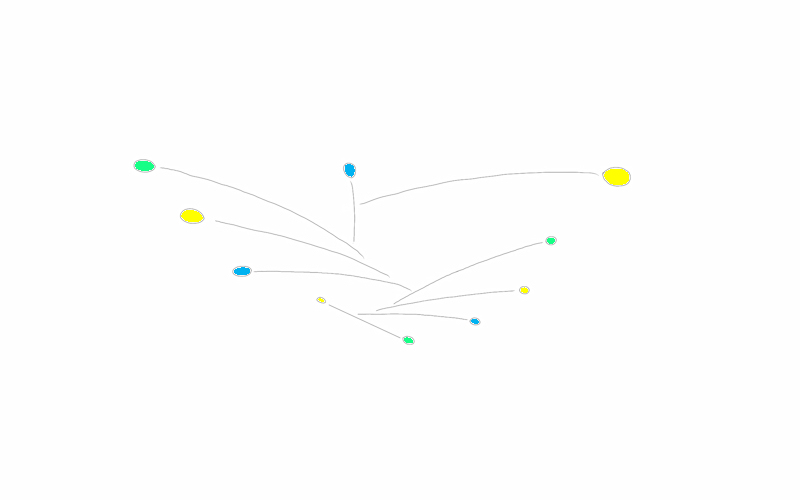

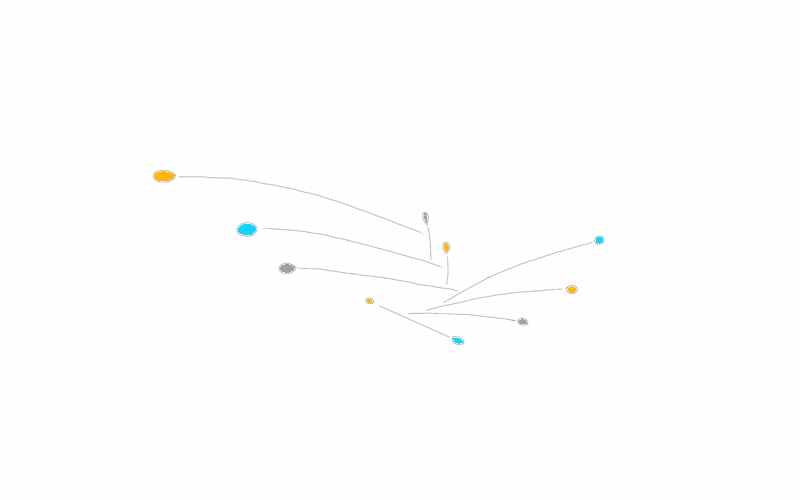
Meet the makers: Marco Mahler and Henry Segerman – Interview with 3D Printing
Meet the makers: Marco Mahler and Henry Segerman
Interview with 3D Printing about our 3D Printed Mobiles

